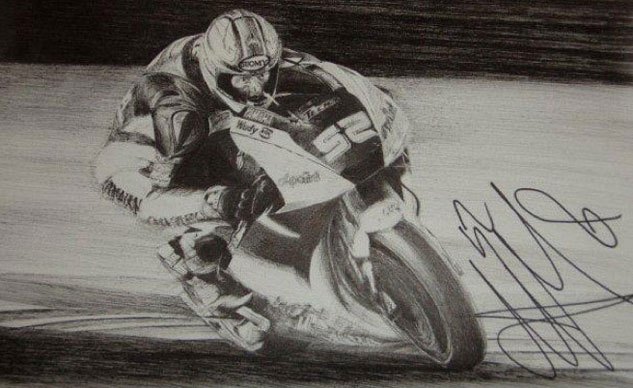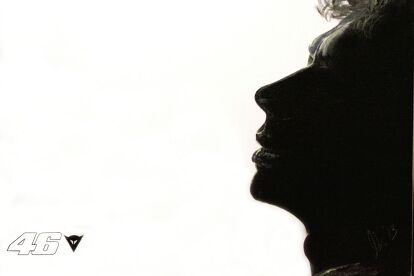The Man Behind The Easel: Motorsports Artist Alex Wakefield

Telling the motorsports story one picture at a time
“Show-wise, I think TC should be all in the wrists. That’s why I like 500s better, and even the first-gen 990s.”
“[Mick] Doohan was one of the gutsiest riders to ever swing a leg over a bike, but I just wish someone could have challenged him.”
“I really wish there were more Americans that could go overseas and be at the front, but the American formula of dirt track doesn’t seem to be the answer anymore.”
“My ‘Beer List’ would have guys like Troy Bayliss, Guy Martin, and John McGuiness. I’d love to grab a drink and hear their stories.”
Listening to Alex Wakefield bench race, you’d think the guy grew up inside the paddocks of some of the greatest racetracks in the world, as his encyclopedic racing memory is quite impressive. However, the truth is far more interesting.
Wakefield was born in, Iowa City, Iowa, but raised in Middletown, Iowa, population 318. While not the first, or even the tenth city you would name when thinking of locales steeped in racing tradition, Wakefield would argue it’s a highly underrated motorsport town. Largely a farming community, he remembers, “[motorsports] just always seemed to be around. There’s a relatively big community there.” Farmers, it turns out, are big gearheads, trading in their tractors for dirt track racecars once the crops are tended to.
After going to the local track every weekend, inevitably, Wakefield couldn’t stand being a spectator anymore, and at 12 tried his hand at kart racing. While fiercely passionate, he was also severely under-funded, laughing at my question about his usual finishing position.
“It was a mess,” he says. “We had such a shoestring budget that sometimes my engine wouldn’t start! Forget trying to run at the front.”
At home, Wakefield was discovering his talent for creating artwork, and soon “it was pretty obvious I was a hell of a lot better artist than I was a driver,” he laments. Artwork became increasingly satisfying, fueling his desire for seat time without ever stepping foot in a car.
But this is Motorcycle.com. Why does this matter?
Because Wakefield is one of us; a true motorsport enthusiast of both two- and four-wheel racing. Despite never owning a motorcycle, he’s always been passionate about the sport, dating back to the issue of Cycle Magazine he picked up in 1988, and what little Grand Prix racing he could find on TV at the time. “I’d see [Randy] Mamola popping wheelies, doing crazy things, and I just absolutely soaked it up.”
Now, he wants to share his passion for motorcycle art with the world. ““I like the freedom of fine art. That’s why I’m going full-bore with it,” he says. “Many of my peers and classmates fell into production design, and I didn’t want to create packaging for things like glue bottles. I enjoy doing motorsport art because there is a story behind it.”
When he agreed to meet with us, Wakefield suggested a Lavazza coffee shop. The distinctly Italian caffeine dispensary would turn out to be a fitting location. Wakefield, like Italians, loves his futbol, caffeine and motorsports. The setting was as close as we could get to chatting in a cafe outside Lake Como. All we needed was pasta and a TV airing MotoGP.
When I arrived, he was already seated, sketchbook open, preliminary strokes of his next piece already started. I happened to catch him during an off day at his 9-5 at Spokes, a bicycle shop near his home in Joliet, IL. “But I’d love to do this for a living,” in reference to his motorsports fine art. It bears repeating how much of a fanatic Wakefield is about motorsport. Whether it’s drivers, riders, races, passes, crashes or championships, he can name them off like no one I’ve ever seen. They hold a special place within because it’s the inspiration he uses to create his art.
“I like stripping stuff away on certain pieces to show the moment that allowed the bigger moment to happen.”
One example was the 2006 MotoGP finale at Valencia. The fight for the title had come down to the last race between Valentino Rossi and Nicky Hayden. Ultimately, Rossi crashed, handing Hayden the championship. Wakefield’s piece, “Grace and Exuberance,” shows a tightly cropped aerial view of Rossi’s hand, scuffed leathers and all, shaking Hayden’s on the cool down lap.
“Rossi would always play mind games with his championship rivals,” says Wakefield. “But he didn’t do any of that with Nicky. They just raced each other, straight up, and Rossi lost. The handshake was a symbolic passing of the torch, and a moment I think was lost considering everything else that happened that day.” Of course, he’s referencing the American winning his only MotoGP championship, but also Troy Bayliss, filling in as a replacement rider, finally winning a MotoGP race. In dominant fashion, too.
Art has always come easy for Alex. He remembers playing with Crayons as a kid, but when other children his age were steered in other directions by their parents, he kept going. For their part, his parents encouraged him. But it wasn’t until he started receiving compliments from complete strangers that he realized he had a talent worth developing.
Throughout the years Wakefield has kept all his sketchbooks, pointing back to certain pieces that indicated progressions. He later attended art school, where his craft was even further refined, which led to a graphic design position at the Indianapolis Motor Speedway. Mecca for a motorsport enthusiast with any appreciation for history.
The position at Indy, while enjoyable, never let Wakefield truly express his artistic desires. Though he distinctly recalls impressing Donald Davidson, Indy’s own in-house historian, with his racing knowledge. “That was one of my happiest memories from working at IMS.” Wakefield’s time at the Brickyard eventually ended, and when it did, motorsport fine art was his release.
As someone with absolutely zero artistic ability, it was particularly interesting for me to delve into Wakefield’s process. If the piece is based on a photo, he’ll study it maniacally to pick up as much detail as possible, from the scuffs on the leathers, to creases in bodywork, to the font of the sponsor decals.
For illustrations, “I’ll sketch a lot in pencil first. For oil paintings I’ll typically lay down a thin ground color to give the piece a mood. Then, my usual method is to work from background out. Lettering is the last thing I add.”
While a fan of the current four-stroke era of grand prix racing, Wakefield was truly inspired by the two-stroke 500cc days. In fact, he thinks back to the 1989 Phillip Island race as the pivotal event that solidified his fandom.
“You had Gardner, Rainey, Lawson, Sarron, Doohan…something like six guys that could have won if they played their cards right. It was a nonstop battle, and by far one of the coolest races anyone will see. Period.” With such a heavy influence on his racing art, it’s no wonder much of his two-wheel subjects are characters of that era.
It’s fitting then that Wakefield credits his illustration of Kevin Schwantz, exiting the first chicane of the Salzburgring, with Mick Doohan hot on his heels, as one of his most meaningful. It was also his first multi-bike illustration.
Through his art, Alex has been fortunate enough to meet some of his heroes, recalling a time he had attended a Rider’s For Health charity auction with Randy Mamola in attendance. He tried to get the grand prix rider’s attention to sign an illustration Wakefield had drawn of him and endorse it during bidding, but he missed his chance. Later in the evening, however, he met Mamola and presented his piece.
“I remember him saying ‘man, I’m sorry I missed you. We could have made some money on that.’” Mamola signed the piece anyway, and thankfully it was auctioned off at a Riders For Health event the following year.
Through art he also had the opportunity to meet Schwantz, whom he briefly did some graphic design work for. “When I shook his hand, I looked down, saw his various scars, and thought ‘now this is a racer’s hand.’” Wakefield placed a bid to design Schwantz’ Brand 34 line of apparel, eventually losing out to one Aldo Drudi, the artist who also does design work for Valentino Rossi.
When Wakefield speaks about motorcycle racing today, I could tell in his demeanor he feels the four-stroke era of grand prix racing has dulled the show. But that doesn’t mean there aren’t characters he still cheers for. A self-proclaimed “big Nicky Hayden fan,” he still yells at his TV in support, “even though I know his Ducati isn’t up for it.”
Speaking of Ducatis, Troy Bayliss is another of the modern riders Wakefield is fond of. His determination and skill on the bike, combined with his friendly Aussie attitude off it, were all factors convincing Wakefield, and his wife, to name their newborn son Bayliss.
Personally, when looking at Wakefield’s art, I see a side to motorsports beyond the checkered flag. “I like to capture the essence from a big moment in racing and tell my own story about it,” he says about his work. It’s a style similar to artist John Singer Sargent, whom Wakefield credits as an inspiration because of his ability to connect with the viewer.
And ultimately, satisfying the viewer is the goal. To get paid to do a commission piece of motorsport art the viewer will absolutely love for years to come, even when he’s not physically there. “That’s all I can ask for,” says Wakefield. “Sure, I’d love to make a full-time living doing this, but I really just love sharing my passion with other people.”
To learn more about Alex Wakefield and to see more of his work, visit his website at motorart27.com or https://www.facebook.com/pages/Orbit-27-Creative/141899122577335

Troy's been riding motorcycles and writing about them since 2006, getting his start at Rider Magazine. From there, he moved to Sport Rider Magazine before finally landing at Motorcycle.com in 2011. A lifelong gearhead who didn't fully immerse himself in motorcycles until his teenage years, Troy's interests have always been in technology, performance, and going fast. Naturally, racing was the perfect avenue to combine all three. Troy has been racing nearly as long as he's been riding and has competed at the AMA national level. He's also won multiple club races throughout the country, culminating in a Utah Sport Bike Association championship in 2011. He has been invited as a guest instructor for the Yamaha Champions Riding School, and when he's not out riding, he's either wrenching on bikes or watching MotoGP.
More by Troy Siahaan



























































Comments
Join the conversation